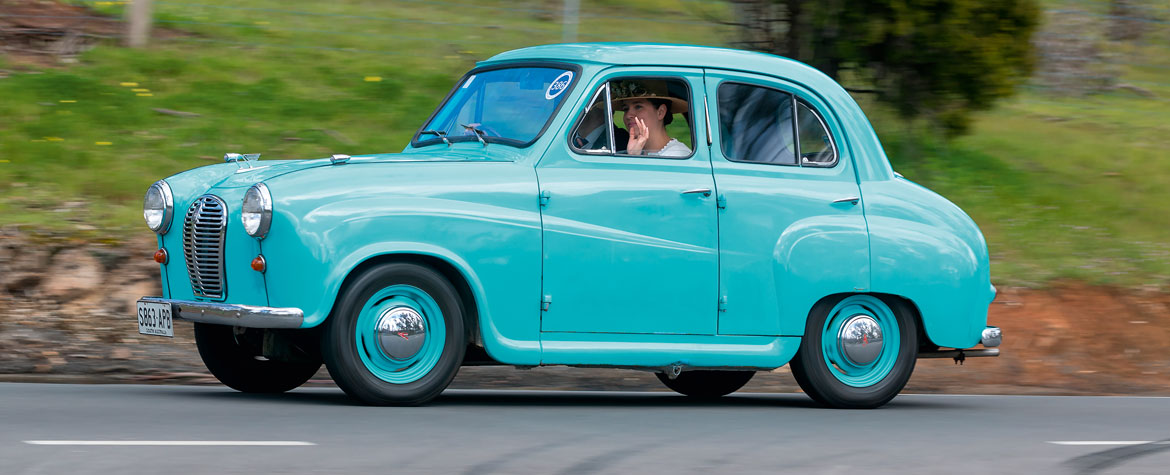
Off to a flying start
David Hill shares fond memories of a family first.
Sixty years ago in Napier, my parents bought their first car.
It was a little British battler: an Austin A30. It cost them about 600 pounds; nine months' wages from my Dad's job as a wool classer. Our one was among the last made; the final A30 trundled off the UK's Birmingham assembly line soon after.
I remember the afternoon my father drove our A30 home. I'd never smelt new upholstery before. The rakish little Flying A on the bonnet seemed the essence of sophistication. Even the grey paint looked stylish.
The car had four forward gears, worked by a skinny floor-shift lever, and a top speed of – ready? – 95km/h. It also had four doors: amazing. The engine: oh, the engine... four inline cylinders, just 803cc and 28 horsepower. With the accelerator floored, it could reach its 95km/h in... in 50 seconds. You weren't likely to leave skid marks when you took off in an A30.
Its revolutionary single-shell body made it lighter than most of its contemporaries. Its having four doors was pretty revolutionary, too. The windows weren't; you slid them up and down by pushing on a clumsy, rough-edged cube of thicker glass glued to their insides. You inevitably ended up with scratched knuckles.
Wipers were one-speed and front only. Radio? Heater? Laugh out loud. Seat-belts? Air bags? Laugh out louder. But it did have a trafficator.
The A30's trafficator was 1950s technology at its peak. It was a clumsy white plastic knob in the middle of the dashboard. “You click it in the direction you want, and the arm pops out,” the salesman told my father.
Yeah, right: You clicked it, and a thin wedge of plastic, illuminated by a 10-watt bulb, crept upwards from a slot in the door pillar, to indicate a turn. It was visible for maybe five metres.
It constantly failed to retract, and was snapped off by the driver's shoulder when s/he opened the door and got out.
We thought the trafficator was wonderful. We thought the whole car was wonderful. Dad and his mate Clarrie spent a weekend with wheelbarrows and shovels, turning part of our front lawn into a concrete pad to park it on. Every night when my father drove home from the Ahuriri woolstores, we'd lovingly spread old sacks across the bonnet, then cover the whole car with a tarpaulin. It was probably the worst thing for the paintwork we could have done, but it made us feel good.
There was great rivalry between the Austin A30 and the sturdy, pudding-bowl-shaped Morris Minor, even though both marques were manufactured by the British Motor Corporation. My parents' friends owned a Morris Minor, and endless comparisons went on. My Mum once let slip that she preferred the Morris lettuce-green to the Austin grey. My Dad was silent for days.
He had his revenge in the Mobil Economy Run, when cars of all types tootled around much of New Zealand, while newspapers and radio reported how many miles per gallon of petrol each consumed.
The A30 proved more economical than the Minor by about one quarter of one per cent. My father smiled triumphantly.
Driving was different in the 1950s. Traffic cops in black uniforms, peaked caps and white gloves stood in the middle of busy intersections at rush hours, directing flow. Slowing down or stopping was indicated with an arm bent at right-angles out the driver's window.
If a funeral procession approached, drivers of other cars took off their hats or pulled respectfully over to the roadside.
I learned to drive in our little Austin, stalling at intersection after intersection, drifting scarily backwards as I tried to master hill starts with handbrake, turning my father's hair greyer as I attempted parallel parking.
Alas, four years after my parents bought it a parked truck waiting outside my Dad's woolstore suffered handbrake failure, rolled backwards, and crushed our A30 against a lamppost. The insurance company (not the AA, I rush to add) sidestepped and delayed and finally agreed to fork out towards a new vehicle. Mum and Dad looked at their finances, took a deep breath, and made one of the most extravagant, daring purchases of their lives. They replaced our A30 with an A35.
Reported by David Hill for our AA Directions Winter 2018 issue
